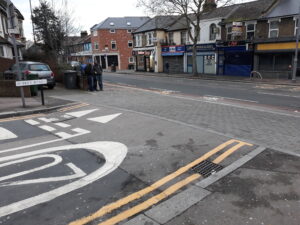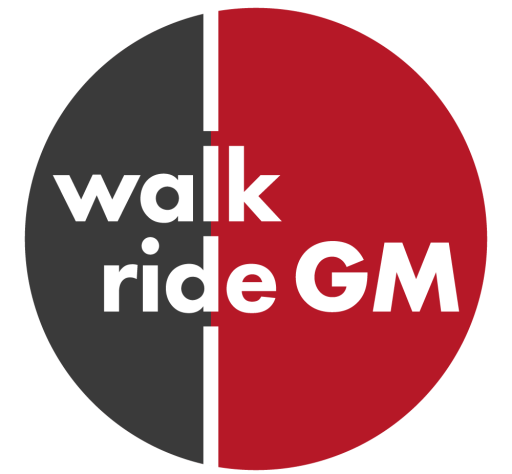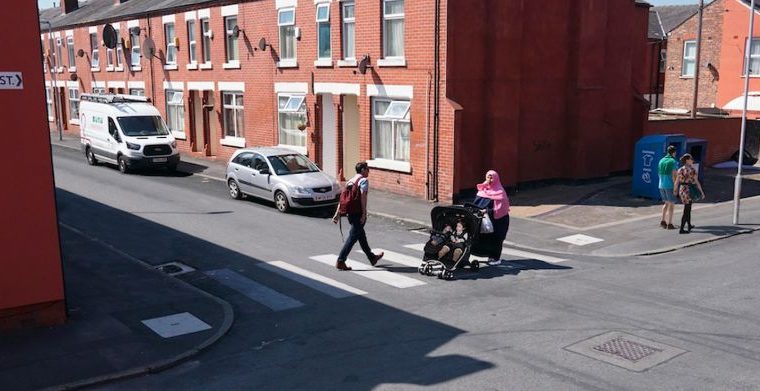Many agree that the status quo is far from pedestrian-friendly in the Greater Manchester city-region. Often these are political choices about the allocation of our public realm to different modes of transport – large portions of this public space is given over to vehicles, with pedestrians kettled to one side.
Walking 🚶is one of the most convenient ways to get around Greater Manchester.
But to make our pavements safe, comfortable, and accessible to all 🧑🦽🧑🦯, people need to be given enough space – such as here, outside @manarndale. pic.twitter.com/ov6m4T9ZpC
— Walk Ride GM (@WalkRideGM) February 28, 2022
Improvement is needed, so we’ve decided to compile a Pedestrian Manifesto: a live and evolving list of required changes across GM, beginning with 8 Things That Would Improve the Pedestrian Experience. Please add your own ideas in the comments below – we can always add to the list.
To clarify, the pedestrian experience includes us all. Within the catch-all term ‘pedestrian’, we include people walking, wheeling, mobility scooting, skipping, using a guide dog, or just resting, playing and spending time in a space (while appreciating the differing needs). None of us goes through life and society without being a pedestrian at one time or another, in one form or another. Here we go then (in no particular order):
Continuous footways
These are now the staple of London Boroughs like Waltham Forest and make movement around its urban areas – from residential neighbourhoods to shops and schools, parks and swimming pools – a better experience for all and can go a long way to enabling 20-minute neighbourhoods.
The idea is that the footway remains level, meaning smoother movement for those crossing side roads, together with giving visual and physical priority to pedestrians, as drivers are met with a raised table so are forced to slow down.
There’s some evidence that these are being built into new road improvement schemes in Greater Manchester, which shows some positive steps. But we need them to be commonplace. We’d suggest letting your local councillors know that you’d like to see these in all new schemes in your area.
Side road zebras
The 2022 Highway Code changes have added emphasis to the existing rules at side roads – that the people moving straight on have the right of way, and if you’re turning then you have to give way. In the absence of continuous footways, there is potentially another (cheaper, quicker) solution.
In November 2021, the Bee Network team published research, conducted in Tameside, that found drivers give way 65% more often with the zebra painted on than without it. The team is awaiting approval by the Department of Transport (DfT) that would lead to permission to paint zebra crossings on side roads across Greater Manchester to help cement pedestrians’ priority.
You see it all over the world – as well as on private land, like supermarkets – and we can’t wait to see these on our public roads here too. We’re waiting for the DfT on this one, but make sure to let your local councillor know about them, so that they know what’s coming soon and what to request of the highways team.
Zebras
While we’re talking about stripy animals, let’s add the beloved zebra crossing to our list. This time I’m talking about the black-and-white paint (and let’s make sure it follows that pattern so visually impaired people’s lives aren’t made worse in order to make a multi-coloured mashup) that enables safe passage from one side of a road to the other.
Even with a pedestrian refuge in the middle of the road, so often people are made to wait far longer than acceptable to cross roads with constant vehicular flow. The widespread application of the humble zebra crossing could help to remedy this – even on crossings with existing refuges. Take this positive example just north of the Greater Manchester conurbation on Blackburn Road, which has evolved from a pedestrian refuge to a fully fledged zebra crossing – enabling significantly more priority for pedestrians, as should be the case.
Instead, the engineering logic too often decides that crossings aren’t required. We need to see better connectivity if we’re to realise pedestrian-friendly neighbourhoods where everything that’s needed lies within a 15-minute walk. If you know a spot where people struggle to cross the road due to constant traffic flow, we’d suggest letting your local councillors know about it.
This is the neighborhood in Amersfoort Netherlands, I grew up in. Red roads are higher traffic, orange is local access calm roads, the yellow are parking areas. Blue is a canal. The rest is all pedestrian infrastructure that children can safely walk around. pic.twitter.com/VTECMAlx2P
— Shmuli Evers (@Shmuli) July 22, 2021
Obstacles
Grey boxes. Digital advertising boards. Electric vehicle charging points. ‘A’-boards.
So @ManCityCouncil have had the great idea of covering the pavements of manc city centre with these ugly grey boxes that will soon be billboards. Simultaneously narrowing the pavements and shoving stupid adverts in everyone’s faces. Fantastic. @AndyBurnhamGM pic.twitter.com/fFwnKfjagY
— George⚑ (@ArtBasher_) November 23, 2021
Whatever the obstacles are, the footway is no place for them. The footway is for pedestrians.
On the grey boxes, MCC’s excuse was that the advertising deal stands to bring in millions of pounds over the contract period – that’s all well and good, but it doesn’t justify plonking these money-makers in busy thoroughfares on the already-limited pedestrian realm, when other, more sensible locations are available.
Obstacles are particularly disorientating for neurodiverse people or people with dementia, and other disabled people.
Solutions should include kerb build-outs and other design considerations at the time of planning consent. Perhaps it’s a question of skills gaps at the councils or perhaps it’s sheer ignorance or negligence of decision-makers; whichever way, improvement is needed. We’d encourage you to speak to your local councillor about any obstacles you’re experiencing on footways or other public realm.
Here’s an example of how kerb build-outs should work:
By April 2022 we plan to have doubled the number of electric vehicle charging points available in the borough. The scheme is one part of our wider plan to help create a greener borough #FairDeal4NextGen
Read more about it here: https://t.co/UATJV3r1kp pic.twitter.com/p5ook1iX6Z— Waltham Forest Council (@wfcouncil) October 28, 2021
Antisocial parking
Similar to the above subheading, in that it’s an unnecessary obstacle impeding pedestrians’ paths. If a car’s dumped over a dropped kerb then it also has negative impacts for people using rolling modes, like wheelchairs or mobility scooters, and should be socially inexcusable.
Added to that, the heavy weight of modern vehicles causes damage to the footway and impacts on councils’ budgets.
Short of walking over cars blocking the footway (‘carwalking‘ – see Richard Ashcroft), there’s not a lot to offer hope of this endemic public space squatting habit changing direction under the status quo. The policing response has been weak and underfunded.
Greater London has benefitted from an assumption against pavement parking, unless otherwise stated, and its pedestrian experience is all the better for it. Outside London, other local authorities such as Derby and Sheffield have seized the initiative and introduced policy – but Greater Manchester’s councils are dragging their heels.
Derby has made the entire city centre a no-pavement-parking zone since 2015. The council believes it to be successful with less pedestrian complaints, and are considering expanding it to other areas of the city. pic.twitter.com/68svSrpGPj
— Alex Romankiw (not Russian) 🇺🇦 (@russiankiwi3) August 15, 2021
Nearly two years on from the national consultation on pavement parking, we await the Government’s proposal (apparently due in June) on how to remedy this situation. But councils can already do this – and it’s remarkably cheap (in public spending terms) to implement too…
Does anyone remember Sheffield City Council announcing a pavement parking ban? I have asked a lot of people why other local authorities outside London are waiting for a change in legislation to enact their own bans…🧵
— Tom is on strike (@TomHainesDoran) March 18, 2022
New Manchester City Council leader Bev Craig stated on Twitter that they are “looking at [a] citywide pavement parking initiative”. There’s no time like the present – let your local council leader know this should be high on their agenda.
We’ve been looking at single yellows and land ownership for those that are parking on forecourt. Also looking at citywide pavement parking initiative too. Always best to send stuff through on email (as well) so we don’t miss it and can pass to the parking enforcement team
— Bev Craig (@bevcraig) March 14, 2022
Traffic light control
Remember when you’ve pressed a beg button at crossroads in the pouring rain and had to wait for traffic going east-west, then north-south, then east-west – again! – before finally being given the green signal to cross? (Take a bow, Dickenson Road/Birch Lane junction, amongst too many others.)
Why should a car being driven a mile down the road have greater priority over our public space than somebody standing right there and then?
TfGM and Local Highways Authorities have the power to control waiting times at traffic lights and can tweak these for a number of reasons. For example, they can do it via sensors, like cameras or ‘loops’, or via timings.
TfGM announced in May 2020 that part of their COVID emergency measures was to enable greater pedestrian priority by lengthening pedestrian phases at Deansgate junctions. Why stop at those?
Take the Netherlands, where they adjust traffic light timings in wet conditions for cyclists; imagine if we could introduce the same for pedestrians here. It’s not beyond the wit of humanity to improve these situations; it just needs willpower. Political will comes from our elected representatives, so make sure your local councillors know how you feel, and to show local support, set up your own Walk Ride group with neighbours if there’s not already one in your area.
Construction
Prior to construction starting, consented major scale planning applications are (or at least should be) subject to the approval of a Construction Environmental Management Plan report (or similar).
These documents are often woefully written in terms of accessibility mitigation for the duration of construction works and even more woefully upheld by local authorities.
This leads to substandard execution on site, which is familiar to us all. Malpractice such as hoardings lumping pedestrians into a cycleway (see Oxford Road during the MMU works), muddy tyre track-out due to negligent HGV wheel washes leading to slippy pavements, crossings, and junctions.
It’s worth highlighting to your councillors any issues that arise from construction periods.
Idling
The proposed Greater Manchester Clean Air Zone (CAZ) is currently under review and we await the Mayor’s new proposal. One of the air pollution impacts on walking environments in particular – including near schools and shops – is when drivers leave their car engine idling while parked up.
Highway Code rule 123 states that:
“You MUST NOT leave a parked vehicle unattended with the engine running or leave a vehicle engine running unnecessarily while that vehicle is stationary on a public road. Generally, if the vehicle is stationary and is likely to remain so for more than a couple of minutes, you should apply the parking brake and switch off the engine to reduce emissions and noise pollution. However it is permissible to leave the engine running if the vehicle is stationary in traffic or for diagnosing faults.”
With 40,000 deaths per year attributable to air pollution, we need this rule to be better enforced.
How about we take the New York approach and enable incentivised crowdsourced reports?
This is amazing. NYC has a bounty program for reporting idling trucks, and one guy made $64k from it last year.https://t.co/BknUTj1OG9
— David Zipper (@DavidZipper) March 19, 2022
Even without the NYC approach, there are ways and means to crack down on this behaviour, so let your councillors know about it.
Do you agree with these? What else would you add? If you agree, let’s make some noise about it – please like and share via social media, email your local councillor and council leader, and email the GM Mayor, Andy Burnham.


2 replies on “The Greater Manchester Pedestrian Manifesto”
It’s a great list! Well done 👍
On the topic of construction I would like to add – please include in construction site planning, where contractors will be parking. Planthill Road in Blackley was badly affected by double pavement parking/blocking bus stops for month, while a new school was being built
Also to make pavements more accessible, safe and attractive, dog fouling and littering should be addressed
[…] issue remains one of the key asks within our Pedestrian Manifesto and now we’re encouraging you to take action by emailing GMUTC@tfgm.com to let them know about […]